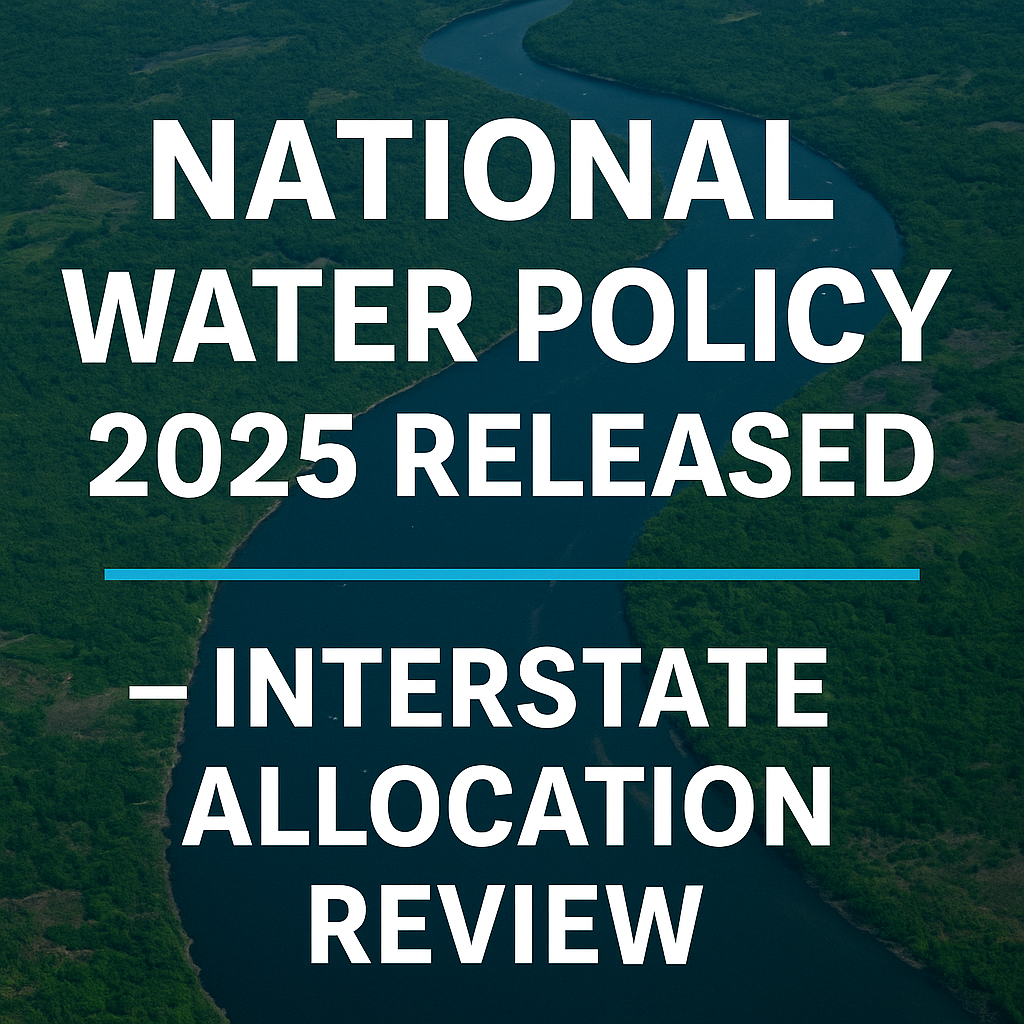
🧭June 14, 2025 Post 2: 🌊National Water Policy 2025 Released — Interstate Allocation Review | High Quality Mains Essay: Rivers Without Borders: National Water Policy 2025 and the Evolution of Cooperative Federalism | IAS-2026 :Prelims MCQs
🌊National Water Policy 2025 Released — Interstate Allocation Review

NATIONAL
📅 Post Date: June 14, 2025
📘 Thematic Focus: Environment | Federalism | Water Governance
🌀 Opening Whisper
“The river knows no borders; today’s policy must bind not divide.”
🔍 Key Highlights
- The revised National Water Policy‑2025 has introduced updated norms for interstate river sharing, marking a shift toward river basin–centric allocations.
- It emphasizes national-level guidelines with provisions for compensation to water-stressed states outside a basin.
- The policy recommends amending the Inter-State River Water Disputes Act 1956, formation of permanent tribunal machinery, and creation of river basin organisations with CM-led councils.
- It also underscores integrated water resource management—promoting recharge, demand management, PPPs, and watershed-centric institutional design.
- The move is likely to reshape centre–state dynamics on water, influence agrarian distress, and feature prominently in GS‑2 and GS‑3 mains answers.
📘 Concept Explainer: Key Innovations in NWP‑2025
- River Basin as Core Unit – Solves allocation by considering hydrological limits rather than political demarcations.
- Permanent Tribunal & Basin Boards – Ensures timely resolution and basin-level cooperation.
- Inter-State Equity Mechanism – Enables transfers to deficit regions via “need‑based compensatory flows.”
- Focus on Sustainability – Encourages recharge, rainwater harvesting, smart irrigation, and PPP-led infrastructure.
🧭 GS Mains Mapping
- GS Paper 2 – Centre–State Relations | Federalism | List of Subjects (Water)
- GS Paper 3 – Agriculture & Water Resource Management | Infrastructure | Disaster Resilience
- GS Paper 1 – Geography: River Basin Systems & Hydrology
- Essay Paper – Federalism in India | Governance and Environmental Sustainability
💭 A Thought Spark — by IAS Monk
“Rivers don’t pause at state lines; policy shouldn’t either.”
High Quality Mains Essay For Practice :
Word Limit 1000-1200
Rivers Without Borders: National Water Policy 2025 and the Evolution of Cooperative Federalism
Introduction
In a country of vast geographic diversity and uneven water availability, managing the equitable distribution of water is both a technical challenge and a constitutional test. India’s rivers flow across political boundaries, but disputes over sharing their waters often result in legal, ecological, and emotional deadlocks. The release of the National Water Policy 2025 (NWP‑2025) marks a paradigm shift: it proposes river basin–based management, permanent tribunals, and compensatory equity models that may finally align the hydrological reality with the federal structure.
This essay examines the context, innovations, and implications of the revised policy, focusing on its potential to transform interstate relations, promote sustainable water use, and redefine centre–state collaboration under India’s federal framework.
Background: The Problem with Current Interstate Water Governance
India has 25 major river basins, most of which span two or more states. Conflicts such as the Cauvery water dispute, Krishna-Godavari sharing, and Yamuna pollution litigation illustrate deep-rooted mistrust, lack of data transparency, and politicisation of water sharing.
Under Article 262 of the Constitution, interstate river water disputes are resolved by tribunals, but:
- They are ad hoc, not permanent.
- Award enforcement is difficult and delayed.
- Tribunals take decades to deliver judgments.
- There is no real-time monitoring of compliance.
Moreover, water is a State subject (List II), but interstate rivers fall under Union purview, leading to a grey zone of administrative overlap.
What’s New in the 2025 Policy?
The NWP‑2025, formulated by the Ministry of Jal Shakti in consultation with NITI Aayog and states, presents five core innovations:
1. River Basin as the Functional Unit
- Allocations will no longer be based on state boundaries but on river basin boundaries.
- Hydrological planning will drive usage norms, bringing science and sustainability into the conversation.
2. Permanent Interstate River Water Tribunal
- The policy recommends a standing tribunal mechanism to resolve disputes proactively.
- This could drastically reduce litigation timelines and enable ongoing dialogue rather than sporadic arbitration.
3. Compensatory Allocation Model
- Water-rich states may compensate deficit states through “virtual water transfers” or guaranteed dry season flows.
- This aligns with the cooperative federalism ethos of shared national resources.
4. River Basin Boards with CM-Led Councils
- Creation of River Basin Organizations (RBOs) for each major river, with Chief Ministers as board members and the Centre as convener.
- This ensures political accountability, transparency, and shared ownership.
5. Integrated Water Resources Management (IWRM)
- The policy focuses on aquifer recharge, smart irrigation, reuse systems, and watershed mapping.
- PPP models and community participation are encouraged to decentralize implementation.
Why This Policy Matters
A. Addresses Agrarian Distress
- States like Maharashtra, Karnataka, Tamil Nadu, and Telangana have witnessed frequent agitations and farmer suicides linked to water shortages.
- A basin-based, data-backed allocation model can bring stability to irrigation planning.
B. Strengthens Federal Governance
- Water has historically been a divisive issue in Centre–State relations.
- NWP‑2025 incentivizes collaboration over conflict, setting precedents for other natural resource policies.
C. Reinforces Environmental Federalism
- Climate stress is turning once-water-abundant states into deficit zones.
- The policy promotes a resilient, flexible water grid across the country, with real-time monitoring and adaptive allocation.
D. Prepares for Urban–Rural Competition
- With rising urban demand (smart cities, industry), rural users face deprioritization.
- NWP‑2025 introduces principles of equitable access, sustainability, and justice in inter-sectoral water use.
Challenges in Implementation
Despite its promise, several practical and political hurdles persist:
1. State Autonomy Concerns
- States may resist ceding control to basin boards or Centre-led tribunals, citing federal encroachment.
2. Data Sharing and Trust Deficit
- Real-time water data is not currently shared between states; mistrust persists over flow volumes, rainfall estimates, and reservoir levels.
3. Infrastructure and Human Resource Gaps
- Establishing basin-level institutions requires trained hydrologists, GIS experts, and legal mediators, which India lacks in quantity.
4. Legal Framework Needs Overhaul
- The Inter-State Water Disputes Act 1956 must be amended to make tribunal decisions binding and time-bound.
- Constitutionally, “water” remains ambiguous between the Centre and states.
Way Forward: Making It Work
A. State Buy-In Through Incentives
- Link water governance reforms with Finance Commission grants, infrastructure funds, or GST compensation, encouraging state participation.
B. Digital Monitoring Systems
- Install sensor-based water level trackers, AI-driven demand forecasts, and real-time dashboards to build shared visibility.
C. Pilot Projects in Sensitive Basins
- Start with politically sensitive but technically manageable basins (like the Narmada or Mahanadi) to test the model.
D. Citizens as Stakeholders
- Empower water user associations, farmers, and civil society to participate in allocation boards and grievance redressal platforms.
Conclusion
India’s river systems are not just hydrological entities—they are social, political, and spiritual lifelines. The National Water Policy 2025 offers a refreshing realignment of ecological logic with governance practice. By prioritizing basin-centric planning, inter-state equity, and institutional redesign, the policy addresses long-standing flaws in India’s water management strategy.
However, success will depend not merely on top-down execution, but on federal trust, scientific data sharing, and community-level implementation. The river, after all, belongs to none and serves all. A true water policy must reflect that truth—in principle and in practice.
Target IAS-26: Daily MCQs :
📌 Prelims Practice MCQs
Topic: National Water Policy
MCQ 1 – Type 1: How many of the above statements are correct?
Consider the following statements about the National Water Policy 2025 (NWP‑2025):
1. The policy proposes river basin–centric water allocation instead of state boundary-based sharing.
2. It mandates the replacement of all water tribunals with Lok Adalats.
3. It introduces a model for compensatory flows to water-deficient regions.
4. It recommends permanent institutional mechanisms for river dispute resolution.
How many of the above statements are correct?
A) Only one
B) Only two
C) Only three
D) All four
🌀 Didn’t get it? Click here (▸) for the Correct Answer & Explanation
✅ Correct Answer: B) Only three
🧠 Explanation:
•1) ✅ True – Basin-based planning is central to the new policy.
•2) ❌ False – It recommends permanent tribunals, not Lok Adalats.
•3) ✅ True – The “compensatory equity model” allows water-rich states to aid deficit states.
•4) ✅ True – Permanent tribunal mechanisms are proposed.
MCQ 2 – Type 2: Two Statements Based
Consider the following two statements:
1. The Inter-State Water Disputes Act, 1956, needs to be amended for smoother implementation of the National Water Policy 2025.
2. Under Article 262 of the Indian Constitution, Parliament can bar the jurisdiction of the Supreme Court in water disputes.
A) Only 1 is correct
B) Only 2 is correct
C) Both are correct
D) Neither is correct
🌀 Didn’t get it? Click here (▸) for the Correct Answer & Explanation
✅ Correct Answer: C) Both are correct
🧠 Explanation:
•1) ✅ True – Amendments are needed for enforcement of time-bound decisions.
•2) ✅ True – Article 262 permits Parliament to restrict SC/HC jurisdiction in inter-state water matters.
MCQ 3 – Type 3: Which of the statements is/are correct?
Which of the following are features of the NWP‑2025?
1. Creation of River Basin Boards with Chief Ministers as members
2. Emphasis on aquifer recharge and watershed-based planning
3. Replacement of PM-KUSUM with a national hydropower grid
4. Inclusion of PPP models in water infrastructure projects
Options:
A) 1, 2 and 4 only
B) 1 and 3 only
C) 2 and 4 only
D) All four
🌀 Didn’t get it? Click here (▸) for the Correct Answer & Explanation
✅ Correct Answer: A) 1, 2 and 4 only
🧠 Explanation:
•1) ✅ True – Basin-level councils with CMs are proposed.
•2) ✅ True – Recharge and watershed models are promoted.
•3) ❌ False – PM-KUSUM is not addressed; no national hydropower grid proposed.
•4) ✅ True – PPP infrastructure is encouraged.
MCQ 4 – Type 4: Direct Fact
Under which Article of the Indian Constitution can Parliament establish adjudication mechanisms for inter-state water disputes?
A) Article 263
B) Article 280
C) Article 262
D) Article 249
🌀 Didn’t get it? Click here (▸) for the Correct Answer & Explanation.
✅ Correct Answer: C) Article 262
🧠 Explanation:
•Article 262 empowers Parliament to create laws for the adjudication of water disputes and allows exclusion of court jurisdiction.


















